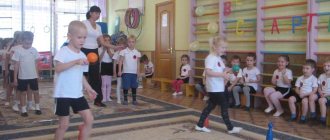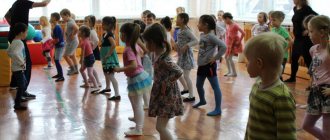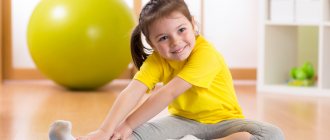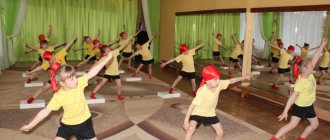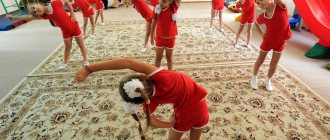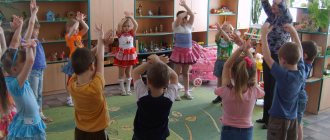Summary of morning exercises for children in the younger group
Summary of morning exercises in the junior group “Walk in the winter forest”
Author: Nadezhda Nikolaevna Panova, teacher of the Irdanovsky kindergarten “Kolosok”, Nikolsky district, Vologda region. Description of the material: The gymnastics summary is intended for young children and will be useful for educators and physical education workers. Goal: create a cheerful, cheerful mood, cultivate the habit of daily physical exercise. 1. Introductory part Children enter the hall, turning to face the teacher. The teacher asks a riddle: Teacher: The scythe has no den, He doesn’t need a hole. Legs save you from enemies, And bark protects you from hunger. (Bunny.) A bunny came to visit us today. And this is not an ordinary bunny, but a magical one. He wants to invite you to the winter forest to play in the snow. Do you like to walk in the forest? How about playing snowballs? (Children's answers). Now you and I will get together with the bunny. The white bunny washes himself, (Children imitate washing) He is going to the winter forest. I washed my tail, (Children stroke themselves on the back.) I washed my ear, (Children massage their ear.) Wiped it dry. The teacher shows the movements and makes sure the kids perform them correctly. So we go to the forest. (Children follow the teacher in a flock) Crunch-crunch-crunch-crunch the snow. We walk past fir trees, birch trees, bushes. (Usual walking is 15 seconds) The branches of the trees became heavy with snow and sank down. The trees look like they are from a fairy tale, fluffy snowflakes cling to all the branches. (Walk with your arms to the sides for 15 seconds). Huge snowdrifts near the roads. (walking, raising your legs high for 15 seconds) Light frost, cheeks red from the frost, but we are warm. (walking) We go for a walk in the forest. We will find a lot of new things, we will meet a cunning fox, we will meet a beautiful Christmas tree. The squirrel will throw us a cone. “Kar-kar-kar,” the crow will ask. “Ding-ding-ding,” the titmouse will sing. A small mouse scurries around. (Alyabyeva E.) And now we will run along the path (running for 20 seconds) So we came to the forest. And in order not to freeze, you and I will do exercises and teach our bunny. We start exercising in the morning. Let diseases fear us, Let them not come to us. Kids, kids - Friendly kids. Kids, kids Go out for exercise. 2.ORU. 1 I.p. - standing, legs together, arms down. Rise on tiptoes, arms up. Lower your entire foot, lower your arms. 4 times. (We will grow big.) 2 IP - standing, legs slightly apart, hands behind your back. Turn your head to the right (left), return to the starting position. 2 times in each direction. (Let's see if a wolf is coming) 3 IP - sitting on your heels, hands behind your back. Get on your knees, stretch your arms forward, palms up, and return to the starting position. 4 times. (Let's show our hands) 4 I.p. - lying on your back, arms along the body. Raise your right (left) leg, bent at the knee, clap your hands under it, return to the starting position. 3 times with each leg. (Let's show our legs) 5 IP - standing, legs slightly apart, hands on the belt. 8-10 jumps, alternate with walking. 2 times. (cheerful kids) 3. final part. Stop, charging has ended. Inhale and exhale for order. Kids, kids - Friendly kids. Kids, kids, did some exercises. The blizzard blew a lot of snow. Covered the entire forest. And the bunny brought us this basket and offers us to throw snowballs into it. Game “Snowballs”. The bunny really enjoyed doing gymnastics and playing with you, but it’s time for us to return to kindergarten. Let's say goodbye to the bunny. (Goodbye, bunny. Come visit us again) Goodbye, good forest, Full of fairy tales and miracles! One, two, three - we circled around and found ourselves in a kindergarten.
We recommend watching:
Health-improving and preventive classes in the senior group of the kindergarten. Notes on physical education classes in the second junior group. Complexes of morning exercises in poetic form for children in the junior group. Notes on physical education in the junior group.
Similar articles:
Morning exercises in the preparatory group in a playful way
How to conduct gymnastics for children 3-4 years old in a preschool educational institution
Any preschool teacher should know some of the features of exercises for 3-4 year olds. They are the basis; without them, morning exercises simply cannot be done.
- Morning exercises in the younger group are carried out strictly before breakfast.
- It consists of exercises that warm up the body and a number of additional restorative ones.
- The lesson should last no longer than 7 minutes, ideally 5 minutes.
- In the warm season, physical education is best done outside, as it will be more useful. In winter, especially in December, exercises should be carried out on the veranda or in a specially equipped room, for example, a games room with mats.
- There are two requirements for the room: the temperature should not exceed 16°C, the room is ventilated before class.
- Children are required to wear sportswear with sneakers and tie up their hair.
- If your child refuses to do the exercises, then you should not force him. But after the lesson you need to ask what was the reason for the refusal.
- If music is turned on while charging, children's interest will increase.
- You should not ask children to strictly adhere to discipline or a clear sequence of movements. Classes should be held in the form of a game, for example, by acting out a skit.
- The mandatory list includes exercises with sports equipment: balls, flags, ribbons, etc.
- The optimal number of repetitions of the task is 5. Practicing one set of exercises is limited to 10 days.
A complex of sleep-awakening gymnastics for the middle group of preschool educational institutions
Important! The teacher should not limit himself to knowledge of the general principles of children’s gymnastics in preschool educational institutions. It is recommended to know the classification of exercises, the content of the exercise itself, techniques for preparation and its successful implementation.
Charging outdoors
Types of exercises:
- general developmental (running, jumping, etc.);
- exercises with elements of a storyline (exercises based on a fairy tale, skit, etc.);
- a set of 3-4 exercises (for example, the “Shaggy Dog” complex, “Train”, etc.);
- alternating running and jumping exercises;
- tasks with attributes (children's expander, trampoline, etc.);
- obstacle course.
Important! The exercises during the obstacle course should not be too difficult so that every student can repeat them.
The main stages of any charging:
- warm-up (walking);
- exercises for various muscle groups;
- leisurely running;
- moderate walking (you can add outdoor play).
The importance of morning exercises in the first junior group of preschool educational institutions
Morning exercises are an element of the daily routine designed to strengthen and maintain the health of children, raise their emotional tone and set them up for further activities.
Goals and objectives of morning exercises for children 1.5–3 years old
The educational goals of morning exercises are universal for preschoolers of any age and boil down to:
- formation, development and improvement of motor skills (for children 1.5–3 years old, this goal is the dominant one, since younger preschoolers are just learning to coordinate their movements, determine the direction of movements of their arms, legs, and torso);
- promoting health (forming correct posture, preventing flat feet, developing a beautiful gait);
- fostering a culture of health (children learn to take care of their health and learn the basics of physical education);
- stimulating interest in sports;
- developing the ability to coordinate one’s actions with the actions of other people;
- nurturing personal qualities (determination, independence, hard work).
Morning exercises create a positive emotional mood in children
To achieve the goals set in the first junior group of a preschool educational institution (DOU), the following tasks are aimed at:
- “awakening” the baby’s body from sleep (even taking into account the fact that preschoolers walk or drive some distance to kindergarten, many of them are in a sleepy state due to early rise);
- activation of the cardiovascular and respiratory systems of the body, organs and channels of perception of the surrounding world (mainly through running and jumping);
- strengthening the musculoskeletal system of children (through repetition of exercises to train the muscles of the shoulder girdle, torso, arms and legs);
- increasing the performance of children (gymnastics helps saturate tissues and organs with oxygen, which means children become more energetic);
- ensuring an organized start to the day (children perform movements together, and all subsequent routine moments in kindergarten also “by inertia” occur harmoniously);
- switching kids to joint activities (even if during the gathering of children in a group the children were playing different games and it was almost impossible to distract them, gymnastics will allow them to switch to a common activity);
- acquaintance with different sports (children not only learn the name, but also correlate the verbal description with the image, try on some sports activities, for example, skates).
MAGAZINE Preschooler.RF
Developed by: Natalia Borisovna Konnova Physical education instructor at MDOU No. 40, Serpukhov 2014 A set of morning exercises for children of the younger group based on the fairy tale “Turnip” - lining up in a column one after another - walking normally - walking on your heels - walking normally - running normally - running with a change of pace - walking normally, forming a circle.ORU complex: 1. “Grandfather planted a turnip, the turnip grew big and very big...” I.p. with 1- hands up through the sides, stand on toes 2- i.p. (4-5 times)
2. “Grandfather began to pull the turnip, he pulled and pulled, but he couldn’t pull it out..” I.p. – o.s., hands on the belt 1- tilt down, reach the floor with your hands 2- i.p (4-5 times)
3. “Grandfather called grandmother, they began to pull the turnip together...” I.p. - heels together, toes apart, hands to shoulders 1- sit down, knees to the sides, arms forward 2- i.p. (4-5 times)
4. “The grandmother called her granddaughter...” I.p. - o.s. 1- turn to the right, right hand to the side 2- ip 3-4- in the other direction (3 times each)
5. “The granddaughter called Zhuchka...” IP - standing on all fours. 1-2- “wag your tail”
6. “The Bug called the cat and the mouse...” I.p.o.s. Jumping on two legs with a turn around (10-15 sec) Alternating with walking in place. “They pulled and pulled... and they pulled out a turnip!” -hold hands and form a large circle. “What a big turnip this is!”
A complex of morning exercises for children of the middle group based on the fairy tale “Tops and Roots”
- formation in a column one at a time - normal walking - walking with a high lift of the hip - walking on the outer arch of the foot - normal running - running in all directions - normal walking - changing into 3 links, opening the open switchgear complex: 1. “a man went to the forest to sow turnips, and a bear will meet him.." I.p.o.s., hands to shoulders 1- stand on toes, elbows up, stretch, 2-p. (5-6 times)
2. “Grandfather sowed turnips, reaped the harvest, tops for the bear, roots for himself...” I.p. - heels together, toes apart, hands on the belt. 1- sit down, tap your fingertips on the floor, 2- i.p. (5-6 times) 3. “The bear got angry, - now it’s the roots for me, and for you, grandfather, the tops!..” I.p.o.s., hands on the belt 1 - tilt to the right, 2 behind the hand. P. 3-4 - in the other direction (4 times) 4. “Grandfather planted wheat, - in the fall he harvested..” I.p. - o.s. 1- bend down - clap under the right knee 2nd p. 3-4 – tilt down, clap under the left knee (4 times) 5. “The bear was angry that his grandfather had deceived him again, and forbade him to plant in the forest..” I.p.o.s., right hand at the top 1- 2 – jerks with arms 3-4 – jerks with changing hands (4 times) 7. “Grandfather began to plant in the field, and the bear began to collect berries and honey in the forest..” Jumping legs together - apart (15-20 sec)
Complex of morning exercises for children of the senior group based on the fairy tale “The Fox and the Jug”
-forming in a line - changing into a column - normal walking - walking on toes - walking in a goose step - walking with a stop at a signal - normal running - running with the shin sweeping backwards - normal walking, changing into three columns, opening Open switchgear complex: 1 “The woman went to the field to reap, and put a jug of milk in the bushes...” I.p.o.s. 1-2- imitation of working with a scythe: “Zhukh-zhukh-zhukh” 2. “The fox drank all the milk from the jug...” I.p.o.s., hands on the belt 1- tilt down, arms back, bend over 2.i .P. (6-8 times)
3. “... the trouble is, my head is stuck in the jug, I can’t get it out..” I.p. feet shoulder-width apart, hands on the belt 1- sit down, clasp your head in your hands 2- stand up, straighten up (6-8 times) 4. “ The fox asked the jug to let her go...” IP - sitting, legs apart 1 - tilt to the right leg, 2 - IP 3 - tilt to the left leg, reach the toe with your hands 4 - IP. (4 times each)
5. “The fox got angry and decided to drown the jug in the river...” I.p., sitting on the floor, bend your legs, clasp your knees with your hands. 1-2-3-4 - rocking on the back.
6. “The jug fell into the river, and dragged the fox with it...” IP - sitting, legs crossed, 1-2-3-4 - rotation of the head to the right, left.
7. Jumping in place, alternating with walking.
| Next > |
Methods used
By the age of three or four, children have almost mastered the entire alphabet and learned to construct sentences to express their thoughts. But some people still have trouble coordinating words (for example, “one ball”). Therefore, in any case, all exercises should be clearly and understandably explained to adults. This will help get rid of speech errors.
Important! The teacher must clearly state all instructions. To make it more interesting, it is better to use rhymes and riddles.
Exercises with rhymes
Visual techniques
The image helps children better understand the world around them. That is why it is best to accompany all classes:
- pictures of animals, cartoon characters;
- step-by-step hand-drawn instructions;
- demonstration of the exercise by the teacher.
Practical technique
This method involves independent activity of children. For example, drawing, making crafts from different materials, etc. This type of activity is very important, because with the help of it, imagination and fine motor skills develop, and children learn to fantasize.
Gaming technique
He is usually accompanied by music. It helps you feel the pace and rhythm of the exercise. Musical tones help you understand when you need to change the nature of your movements. For example, calm music encourages moderate walking, while cheerful and lively music encourages running and jumping. In addition, it increases the discipline, efficiency, and attentiveness of children.
Objectives and goals of physical education
